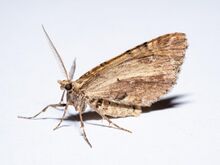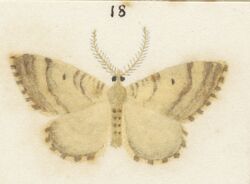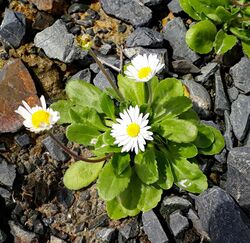Biology:Asaphodes aegrota
| Asaphodes aegrota | |
|---|---|
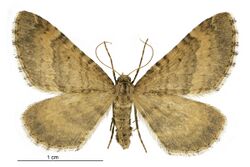
| |
| Female | |
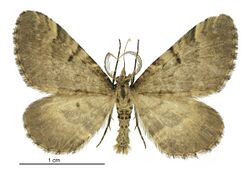
| |
| Male | |
| Scientific classification | |
| Domain: | Eukaryota |
| Kingdom: | Animalia |
| Phylum: | Arthropoda |
| Class: | Insecta |
| Order: | Lepidoptera |
| Family: | Geometridae |
| Genus: | Asaphodes |
| Species: | A. aegrota
|
| Binomial name | |
| Asaphodes aegrota (Butler, 1879)[1]
| |
| Synonyms[2][3] | |
| |
Asaphodes aegrota is a species of moth in the family Geometridae.[4] It was first described by Arthur Gardiner Butler in 1879 as Selidosema aegrota. It is endemic to New Zealand and can be found in the North, South and Stewart Islands. This species inhabits open spaces in lowland native forest. The larvae of A. aegrota feed on native herbs and have also been observed feeding of the introduced lawn daisy. The adults are variable in appearance with the markings on both sides of its wings varying in intensity. Some populations also have narrow winged females. Adults are on the wing from November until March.
Taxonomy
This species was first described by Arthur Gardiner Butler in 1879 using specimens collected at Wairarapa by F. W. Hutton and named Selidosema aegrota.[5] George Hudson discussed and illustrated this species under the name Xanthorhoe aegrota in 1898 and again in 1928.[6][3] In 1939 Louis Beethoven Prout placed this species in the genus Larentia.[7] This placement was not accepted by New Zealand taxonomists.[8] In 1971 J. S. Dugdale placed this species in the genus Asaphodes.[9] In 1988 Dugdale confirmed this placement in his catalogue of New Zealand Lepidoptera.[2] The male holotype specimen is held at the Natural History Museum, London.[2]
Description
Butler originally described this species as follows:
Whity-brown, wings with a marginal series of small blackish spots in pairs; fringe white, spotted with blackish and intersected by a dark grey line ; basal two-thirds of the primaries crossed by about seven parallel dusky lines commencing upon the costal margin in black dots ; discocellulars black ; under surface of primaries greyish-brown with pale grey borders, the costal border crossed by four or five white-edged blackish dashes ; marginal spots as above ; secondaries white, crossed by about eight strongly arched parallel brown lines which become very indistinct upon the costal area ; disc from the radial to the abdominal margin clouded with brown ; marginal spots as above ; body white.[5]
This species is variable in appearance and the intensity of the markings on both the lower and upper sides of its wings can vary considerably.[3] It also has populations that have narrow winged females such as in the Wairau Valley, Marlborough.[9]
Distribution
This species is endemic to New Zealand and can be found on the North, South and Stewart Islands.[1][3]
Habitat
This species inhabits open spaces in lowland native forest.[3] Hudson observed it amongst Discaria toumatou.[3]
Behaviour
The adults of this species are on the wing from November until March.[3]
Host species
Larvae of this species feed on herbs.[10] They have also been found feeding on introduced lawn daisies.[11][12]
References
- ↑ 1.0 1.1 "Asaphodes aegrota (Butler, 1879)". Landcare Research New Zealand Ltd. http://www.nzor.org.nz/names/a19eaace-e584-4046-bdc9-e86c52188239.
- ↑ 2.0 2.1 2.2 , pp. 172, Wikidata Q45083134
- ↑ 3.0 3.1 3.2 3.3 3.4 3.5 3.6 , pp. 120, Wikidata Q58593286
- ↑ , p. 458, Wikidata Q45922947
- ↑ 5.0 5.1 , pp. 499, Wikidata Q104215588
- ↑ , pp. 64, Wikidata Q19073637
- ↑ Prout, L. B. (1939). "Geometridae: Fauna Indo-Australica". The Macrolepidoptera of the World 12: 264. https://www.biodiversitylibrary.org/page/12779936.
- ↑ , Wikidata Q54670161
- ↑ 9.0 9.1 , Wikidata Q64006453
- ↑ , Wikidata Q54578259
- ↑ , Wikidata Q109608608
- ↑ , Wikidata Q105344866
Wikidata ☰ Q15639974 entry
 |
